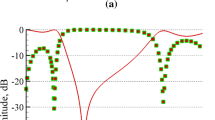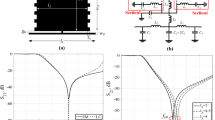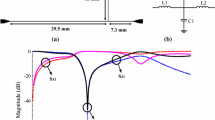Abstract
A new microstrip lowpass filter with compact size, ultra-wide stopband and sharp cutoff frequency is proposed. To achieve an ultra-wide stopband and sharp cutoff frequency, two Z-shaped resonators are added to the filter. To reduce the circuit size of the filter, cursive transmission line is also introduced. Moreover, exact equation for the most important transmission zeroes are obtained based on LC equivalent circuit and transfer function. A demonstration filter with 3 dB cut-off frequency at 1.89 has been designed, fabricated and measured. The results show a relative stopband bandwidth of 166.3 % (referred to suppression degree of 25 dB), and a high figure of merit of 32,613.
Similar content being viewed by others
Avoid common mistakes on your manuscript.
1 Introduction
High-performance and compact size lowpass filters (LPF) with wide stopband and sharp cutoff frequency are highly demanded in many communication systems especially in wireless and mobile communications in order to suppress high frequency harmonics [1]. In [2], a lowpass filter using shunt open-stubs at feed points of a center fed coupled-line hairpin resonator was presented. The filter has a wide stopband, but the cutoff frequency was not enough sharp. In [3], a lowpass filter was presented circular-shaped patches and open stubs to achieve sharp roll-off and ultra-wide stopband, but the structure of the filter was not symmetrical. In [4], a new transformed radial stubs (TRSs) with an extended stopband was introduced. In [5], a new microstrip lowpass filter with compact size and an ultra-wide stopband using both triangular patch resonators and radial patch resonators were presented. Sharp roll-off and wide stopband lowpass filter based on radial split ring was presented in [6]. Authors in [7] proposed a lowpass filter with a very sharp transition band and wide stopband. In [8], coupled-line structure and shunt open stub with compact size and a wide stopband were reported. In this paper, a novel lowpass filter with ultra-wide stopband and small size is presented. To achieve wide stopband, Z-shaped and T-shaped resonators are employed. The filter has an ultra-wide stopband from 2.06 GHz up to 20 GHz with large attenuation of more than 25 dB.
2 Analytical Method
Figure 1a shows the layout of the resonator composing of two modified T-shaped resonators. The purpose of using T-shaped resonator is its sharp cut-off frequency response. The equivalent LC circuit of the main resonator is shown in Fig. 1b so that L2, L3 and C1 are inductances and capacitance of high-impedance lossless line. L1 denotes the inductance of the transmission line and C2 is the sum of equivalent capacitances of open-end and high-impedance lossless line. The values of these parameters can be extracted using the methods discussed in [1].
The calculated values for LC equivalent circuit are summarized in Table 1.
The EM and equivalent circuit simulation results of modified T-shaped resonators are in good agreement as shown in Fig. 2a. Figure 2b shows the frequency response of the modified T-shaped resonators, which has two transmission zeroes at 2.4 and 13.1 GHz with 25.4 and 30.2 dB attenuation level respectively. Since the cut-off frequency and sharpness in transition band are controlled with the first transmission zero, the first transmission zero affects more important than another one.
In this work, we utilized LC model and transfer function for the calculation of the first transmission zero. Transfer function is extracted from LC circuit in Eq. (1). r in Eq. (1) refers to resistance of matching. The transmission zero can be calculated in Eq. (2) using the transfer function in Eq. (1).
where
As can be seen in Eq. (2), the location of transmission zero can be adjusted by changing the capacitances and inductances values. For instance, if L3 changes to 1.5, 1.95, 2.7 nH, the dimension of A (as shown in Fig. 1) will change to 3, 3.8 and 5 mm respectively, having fz at 2.71, 2.41and 2.11 GHz respectively, as shown in Fig. 3.
Figure 4a shows layout of Z-shaped resonators. The resonators can generate transmission zero for increasing width of stopband and sharpness in transition band. LC equivalent circuit of resonators is shown in Fig. 4b so that inductances and capacitances are exploited of high and low-impedance lossless line, open–end, gap and bend structures. The calculated values for LC equivalent circuit are summarized in Table 2.
Figure 5a shows frequency response of the Z-shaped resonators. As shown in Fig. 5b, the EM and equivalent circuit simulation results of the main resonator are in good agreement. Z-shaped resonator can create four transmission zeroes at about 3.5, 5, 12.8 and 18.5 GHz. As can be seen, transmission zeroes at 3.5 and 5 GHz are important than other transmission zeroes so we calculate them in Eq. (3).
where
for first transmission
for second transmission
mIllustrated in Fig. 6a, Main resonator is generated by composing T-shaped and Z-shaped resonators. Figure 6b, c show layout, LC equivalent circuit and frequency response of main resonator. In LC equivalent circuit, the effect of coupling between T-shaped resonator and Z-shaped resonators is ignored because frequency response of layout and LC equivalent circuit are similar and we can use the calculated fz1, fz2 and fz3 for this resonator.
3 Lowpass Filter Design
In order to extend the stopband, transmission peaks should be suppressed by adjusting some transmission nulls created by appropriate suppressing cells. One of the commonest suppression cells for extending the stopband width is the T-shaped resonators. Figure 7 shows the frequency response of T-shaped resonator, which has two transmission zeros at 10 and 13.7 GHz with 88 and 78 dB attenuation level respectively.
T-shaped and Z-Shaped resonators increase stopband width, but the circuit size becomes larger. To decrease the circuit size of the filter, transmission line is bent. This method produces a small capacitance, reducing the return loss and attenuation level of the stopband from 20 to 25 dB as shown in Fig. 8.
The dimensions of the designed filter in Fig. 9 are as follows: L1 = 1.17, W1 = 6.95, L2 = 11.9, W2 = 1.48, L3 = 3.4, W3 = 4.4, L4 = 4.3, W4 = 3, L5 = 3.7, W5 = 3, L6 = 6.55, W6 = 2.8, L7 = 6.8, W7 = W8 = L8 = L9 = 0.1, W9 = WB1 = 0.3, WB2 = 0.8 (all in millimeter).
4 Simulation and Experimental Results
The proposed lowpass filter has been fabricated on a substrate with a relative dielectric constant \(\varepsilon _\mathrm{r}=3.38\), thickness h = 20 mil, and loss tangent \(\delta =0.0021\). Figure 10a shows a photograph of the proposed filter. Simulations are done by an EM-simulator ADS based on the method of moment. The S-parameters are measured by an Agilent network analyzer N5230A. Simulated and measured responses of the filter are shown in Fig. 10b. It can be seen from the results that the filter has 3 dB cutoff frequency equal to 1.89 GHz, insertion loss less than 1.8 dB in the passband from DC to 0.5 GHz, return loss better than \(-10.3\) dB and suppression level better than \(-25\) dB from 2.01 up to 20 GHz. The size of the lowpass filter is only \(19.9 \times 8.5\) mm and the transition band from 1.89 to 2.05 GHz with \(-3\) and \(-20\) dB.
For comparison, Table 1 provides a breakdown of some lowpass filter performance where the roll-off \(\xi \) rate is defined as:
where \(\alpha _{\max }\) the 40 dB attenuation is point and \(\alpha _{\min } \) is the 3 dB attenuation point, \(f_s\) is the 40 dB stopband frequency and \(f_c\) is the 3 dB cut-off frequency. The relative stopband bandwih (RSB) is calculated by:
The suppression factor (SF) is based on the stop-band bandwidth. For example, the stop-band bandwidth is referred to 25 dB suppression, thus the corresponding SF is defined as 2.5. A higher suppression corresponds to a greater SF. The normalized circuit size (NCS) is calculated by:
where \(\lambda _\mathrm{g}\) is the guided wavelength at 3 dB cutoff frequency. The architecture factor (AF) can be recognized as the circuit complexity factor, which is equal to 1 when the design is 2D and it is equal to 2 when the design is 3D. Finally, the figure-of-merit (FOM), the overall index of a proposed filter, is given by:
As seen from this table, the proposed filter offers good performance, compact size, ultra-wide stopband and outstanding electrical performance among the quoted filters, being more suitable for using in modern UWB systems (Table 3).
5 Conclusion
A lowpass filter with 1.89 GHz cut-off frequency using the modified T-shaped resonator has been designed, fabricated and measured. The proposed lowpass filter has exhibited many desirable features, such as ultra-wide stopband, sharp characteristic and compact size. This paper has presented a novel analytical method based on calculated and examined transmission zero and transformation function of the main resonator. With all these good features, the proposed filter is applicable for modern communication systems.
References
Hong, J. S., & Lancaster, M. J. (2001). Microstrip filters for RF/microwave applications. New York: Wiley.
Krishna Velidi, V., & Sanyal, S. (2011). Sharp roll-off lowpass filter with wide stopband using stub-loaded coupled-line hairpin unit. IEEE Microwave and Wireless Components Letters, 21(6), 301–303.
Karimi, G., Lalbakhsh, A., & Siahkamari, H. (2013). Design of sharp roll-off lowpass filter with ultra wide stopband. IEEE Microwave and Wireless Components Letters, 23(6), 303–305.
Ma, K., & Yeo, K. S. (2011). New ultra-wide stopband low-pass filter using transformed radial stubs. IEEE Transactions on Microwave Theory and Techniques, 59(3), 604–611.
Wang, J., Xu, L.-J., Zhao, S., Guo, Y.-X., & Wu, W. (2010). Compact quasi-elliptic microstrip lowpass filter with wide stopband. IEE Electronics Letters, 46(20), 1384–1385.
Hayati, M., Asadbeigi, H., & Sheikhi, A. (2012). Microstrip lowpass filter with high and wide rejection band. Electronics Letters, 48(19), 1217–1219.
Hayati, M., & Sheikhi, A. (2011). Microstrip lowpass filter with very sharp transition band and wide stopband. ETRI Journal, 33(6), 981–984.
Krishna Velidi, V., KantiMandal, M., & Sanyal, S. (2009). Compact lowpass filters, microstrip coupled-line lowpass filter with wide stopband for RF/wireless systems. ETRI Journal, 31(3), 324–326.
Author information
Authors and Affiliations
Corresponding author
Rights and permissions
About this article
Cite this article
Karimi, G., Siahkamari, H., Khamin Hamedani, F. et al. Design of Modified Z-Shaped and T-Shaped Microstrip Filter Based on Transfer Function Analysis. Wireless Pers Commun 82, 2005–2016 (2015). https://doi.org/10.1007/s11277-015-2328-z
Published:
Issue Date:
DOI: https://doi.org/10.1007/s11277-015-2328-z














